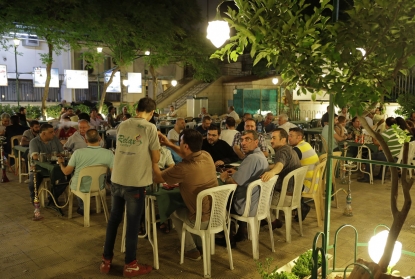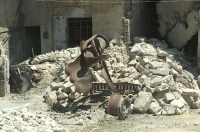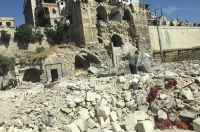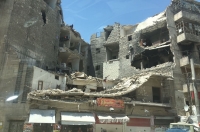Pilgrimage through a Syria at war
Aleppo -- My last journey to Syria will remain etched in my memory, more like a pilgrimage than a reporting assignment.
I went to Damascus, Hama, Lattakia, Aleppo -- places whose suffering and destruction I have been covering from AFP’s bureau in Beirut. For years I and my colleagues in the bureau have been talking to reporters on the ground in Syria on a daily basis. I have talked to them as they huddled through bombings, as they cried over loved ones killed, as they held back tears and madness after witnessing the death, suffering and destruction again, and again, and again. And now I was seeing for myself these places that I have gotten to know so intimately from a distance.
During the week-long trip, I also got a sense of a post-war Syria, slowly being built atop the remnants of thousands of shattered lives.
 A picture taken on July 3, 2016 from the UNESCO-listed citadel in the government-controlled side of the divided northern Syrian city of Aleppo shows damaged buildings, including the ancient Great Umayyad Mosque (L) at the foot of the medieval fortress. (AFP / George Ourfalian)
A picture taken on July 3, 2016 from the UNESCO-listed citadel in the government-controlled side of the divided northern Syrian city of Aleppo shows damaged buildings, including the ancient Great Umayyad Mosque (L) at the foot of the medieval fortress. (AFP / George Ourfalian)At the gates of Aleppo city, the scene is bucolic: olive trees, sheep, an open plain. But as we get closer, the vista is brutally replaced by one of charred cars and pancaked concrete shops.
Our team, including photographer Joseph Eid and videographer Youssef Karwashan, drives into Ramussa, a neighborhood on Aleppo's southern outskirts and the scene of fierce fighting between government forces and rebels.
The stories we wrote about this place come back to me in vivid flashbacks. Just six months ago, the area was a warzone, as the army battled to seize eastern Aleppo from rebels. Some of the most violent clashes centred around the military academies in the neighbourhood and the Sheikh Saeed cement factory, which is miraculously still intact, though shuttered.
 A picture shows a destroyed factory in Aleppo's northwest Layramoun industrial district on July 5, 2017. (AFP / Joseph Eid)
A picture shows a destroyed factory in Aleppo's northwest Layramoun industrial district on July 5, 2017. (AFP / Joseph Eid)The silence is deafening, the streets are deserted, and we feel as though we are in an open-air war museum. But it is only a taste of what awaits inside the city.
Our first story practically falls into our laps: the recent reopening of the Ramussa bus station. This was the crossing point for thousands of rebels and civilians being evacuated from the city in December 2016, before Syria's army announced its full recapture. Among them was our correspondent Karam al-Masri, the only reporter for an international news organisation still inside the besieged east at the time.
Six months later, it is crisscrossed with a new set of tragedies. Ramussa now shelters families fleeing the latest battle in Syria to make international headlines: the fight to dislodge the Islamic State group from its bastion of Raqa. Even for them, the devastation is jarring. A woman from Raqa who had visited Aleppo in her youth told me she couldn't believe her eyes when she saw the destruction in the city.
 Displaced Syrians who fled with their families Islamic State controlled areas in Raqa, Deir Ezzor and Mayadeen gather at Aleppo's bus station of Ramussa on July 4, 2017. (AFP / Joseph Eid)
Displaced Syrians who fled with their families Islamic State controlled areas in Raqa, Deir Ezzor and Mayadeen gather at Aleppo's bus station of Ramussa on July 4, 2017. (AFP / Joseph Eid)Like her, I had visited Aleppo as a teenager, but I have retained little more than vague memories of the place, and the eternal regret that I never explored the city's full splendour before it was disfigured.
In what was rebel-held Aleppo, life is making a cautious comeback. I make my way through a maze of buildings whose floors have collapsed like houses of cards. I spot a baker, then a butcher shop. Further on, surrounded by ravaged homes, wooden carts are overflowing with fruit and vegetables. The same stalls had been barren when Karam, hungry and dreaming of being able to eat a kiwi or a cherry, photographed them for us during the worst days of Aleppo's siege.
 A picture taken on March 9, 2017 in the northern Syrian city of Aleppo, which was recaptured by government forces in December 2016, shows people purchasing vegetables in the formerly rebel-held al-Shaar neighbourhood. (AFP / Joseph Eid)
A picture taken on March 9, 2017 in the northern Syrian city of Aleppo, which was recaptured by government forces in December 2016, shows people purchasing vegetables in the formerly rebel-held al-Shaar neighbourhood. (AFP / Joseph Eid)Like all journalists in Syria on government visas, we are accompanied by a representative from the information ministry. She was in Aleppo just after the army had recaptured it and says that today's open, drivable streets had then been filled with debris.
But some parts of the east have been frozen in time since December. I find myself confronted by a scene of devastation on hold, enveloped in an eerie silence. In these parts of east Aleppo, there are ghosts that speak to you: the ghosts of thousands of Aleppans who demonstrated against the regime, the Aleppans buried beneath the rubble, and the Aleppans who left these destroyed streets behind.
You can find them in the living room exposed to the elements by a gaping hole blown through a building. You can find them in the lonely mattresses perched on mounds of rubble, and the dislodged fans hanging off balconies in scenes worthy of a Dali painting.
In the streets of Kalasseh, Shaar, Inshaat and Bab al-Faraj -- names that appeared unrelentingly in our AFP dispatches -- I can't stop snapping pictures. I feel a compulsive need to immortalise what will disappear in a few months, or perhaps a few years, forever erasing the aftermath of a horrifying war.
As I walk the streets, I remember my trip to the Old City of Homs in 2014, after a similar evacuation of rebels and civilians to opposition territory elsewhere in the country. I also feel a distant echo of my own city Beirut, whose downtown I crossed on foot in the early 1990s just after Lebanon's 15-year civil war came to a close.
But in Aleppo, the scale of the destruction is so massive, the skeletal remnants of the buildings make the scene surreal.
At the end of the two-day trip, I flick through my photos incessantly. Snapshots of destruction, one after another like a kaleidoscope, a vision of suffering multiplied to infinity.
But amid the rubble blossom stories that inspire hope. In a half-deserted street in the Kalasseh neighbourhood, I see two men lifting equipment into an apartment via a pulley.
 A Syrian artisan sews a handmade rug at his workshop in the capital Damascus on July 9, 2017. (AFP / Joseph Eid)
A Syrian artisan sews a handmade rug at his workshop in the capital Damascus on July 9, 2017. (AFP / Joseph Eid)We go up to the second floor and find a business owner who has managed to restart a small workshop making plastic products.
In a nearby building, another entrepreneur has restarted his weaving machines. It's a hive of activity, but still a long way from the massive textile production that gave Aleppo its reputation as the capital of the industry -- not only in Syria but across the broader Arab world.
In the industrial district of Layramun, on Aleppo's northwestern outskirts, the devastation is breathtaking. It's a graveyard of factories, full of melancholic, dust-covered machines.
I notice sandbags to my right, and a military outpost.
"They're on the other side, don't come too close," a soldier tells us.
“They" refers to the rebels, still stationed on the western outskirts of the city. The war is still here.
 Syrians carry a body of a fighter during a funeral after Friday prayer in the northeastern city of Aleppo on February 15, 2013. (AFP / Bulent Kilic)
Syrians carry a body of a fighter during a funeral after Friday prayer in the northeastern city of Aleppo on February 15, 2013. (AFP / Bulent Kilic)Aleppo's government-held west has also been affected by the war, even if the damage is not comparable.
In the Armenian district of Midan, we find a cafe that has just reopened after four years of rebel fire on the frontline neighbourhood.
Now, the roar of rockets has been replaced by the sound of children laughing and customers clinking glasses of arak, a Levantine liquor. It is a small glimpse of the pre-war Aleppo I never knew.
 Syrians from Aleppo's Armenian community have dinner at a cafe in the al-Midan neighbourhood of the northern Syrian city on July 5, 2017. (AFP / Joseph Eid)
Syrians from Aleppo's Armenian community have dinner at a cafe in the al-Midan neighbourhood of the northern Syrian city on July 5, 2017. (AFP / Joseph Eid)Some of the city's most famed icons are now but a shadow of their former selves: the celebrated Baron hotel, where former French president Charles De Gaulle and writer Agatha Christie once stayed, is a desolate place. One entrance to the city's ancient covered market, the oldest in the world, is still blocked by debris.
Saadallah al-Jabiri place and the Aleppo citadel, both longtime symbols of the city, are now lit for the first time in four years. But the square is now dominated by a giant portrait of President Bashar al-Assad that reminds locals who the victor here is. The citadel remains a military position.
 A picture taken 17 March 2006 shows a general view of the historic Syrian city of Aleppo, 350 kms north of Damascus, with its landmark cytadel in the background. (AFP / Ramzi Haidar)
A picture taken 17 March 2006 shows a general view of the historic Syrian city of Aleppo, 350 kms north of Damascus, with its landmark cytadel in the background. (AFP / Ramzi Haidar)Even the nightlife is marked by the legacy of war. Russian soldiers are regular customers at Aleppo's once-renown restaurants. Business at cafes and hotels is dictated by the rhythm of consecutive power cuts, leaving air conditioning units virtually useless against the heat wave.
Before the war, Aleppo -- like many Arab cities -- never slept. Now, it feels the way Damascus has since early on in Syria's war. Not a single cat can be seen roaming the streets, except in the Mogambo neighbourhood, where young people crowd into fast-food restaurants.
The routes from Damascus to Aleppo, then Aleppo to Lattakia, are dotted with detours because of the continuing rebel presence that slices through loyalist territory. Along the way are names that we in AFP's Beirut bureau have memorised after six years of poring over maps to cover the conflict.
The trip starts out from Damascus and leads us first through the central province of Homs, looping around rebel-held towns like Harasta. We pass Homs city, and enter Hama province to take the famed Khanasser road. The beginning of the highway is marked by checkpoints manned by pro-government foreign fighters taking selfies with Iraqi and Afghan flags behind them.
 Syrian pro-government forces walk on a road through the town of Khanasser, which is the sole link between government-held areas in and around Aleppo and those in the rest of the country, after they reportedly recaptured it from Islamic State (IS) group fighters, on February 29, 2016.
(AFP / Georges Ourfalian)
Syrian pro-government forces walk on a road through the town of Khanasser, which is the sole link between government-held areas in and around Aleppo and those in the rest of the country, after they reportedly recaptured it from Islamic State (IS) group fighters, on February 29, 2016.
(AFP / Georges Ourfalian)This thoroughfare, also known as the Damascus-Aleppo highway, faces regular albeit short attacks by the Islamic State group. The attacks are so frequent that they don't make news -- instead, they've almost become a joke.
But when I find myself physically on the road, I have no desire to laugh whatsoever. For an hour or more I see burned-out vehicles belonging to the Syrian army or their Russian allies on either side of the road, obviously the remnants of recent IS attacks. Not funny at all.
We take the Khanasser road again on our way out of Aleppo in order to reach the coastal province of Latakia in the west. It's a bizarre detour made necessary by the fact that between the two areas lies Idlib, the last province in the country that remains entirely outside regime control.
 Syrians spend time on the shores of the Mediterranean Sea in Wadi Qandil north of the seaside city of Latakia on July 6, 2017. (AFP / Joseph Eid)
Syrians spend time on the shores of the Mediterranean Sea in Wadi Qandil north of the seaside city of Latakia on July 6, 2017. (AFP / Joseph Eid)A trip that in the past would have taken two hours, now takes five. In Aleppo's Ramussah station, I am astonished to meet a driver from Idlib who still travels once a week from the rebel-held province all the way to Damascus. Before the war he used to make the trip twice a day.
"It's not simple," he says.
As we pass through Hama city, nervous soldiers conduct a particularly robust inspection of our car -- a suicide attack has just hit the city. To continue on to Latakia, our driver turns onto the Mehardeh road. Mehardeh! We know the name very well because it, too, is regularly attacked by rebels and jihadists. I see sandbags on either side of the highway to protect passing vehicles from sniper fire. The road is deserted, as are the houses along it. We fume at the driver, but he insists the route is safe. I send my GPS location by Whatsapp to my colleagues in Beirut. Just in case.
At one crossroads I see a sign pointing drivers towards areas in Idlib province, an area to which I have no access. We use Whatsapp to communicate with our correspondent there. So close, but still so far.
I even find traces of Aleppo in Latakia, interviewing families from the city who have sought refuge in this seaside stronghold of the Assad clan.
In nearby Wadi Kandil, on the endless beach bathed in the orange of the setting sun, it's hard to believe this peaceful landscape could belong to such a devastated country. Here, people smoking shisha in the shade are not particularly eager to discuss politics and war. "It's true that our area has not been affected in the same way as the rest of the country," says one relaxed smoker. "But we have given the blood of our young men for the army."
 Syrians spend time on the shores of the Mediterranean Sea in Wadi Qandil north of the seaside city of Latakia on July 6, 2017. / AFP PHOTO / JOSEPH EID (AFP / Joseph Eid)
Syrians spend time on the shores of the Mediterranean Sea in Wadi Qandil north of the seaside city of Latakia on July 6, 2017. / AFP PHOTO / JOSEPH EID (AFP / Joseph Eid)Through snippets of conversation, you realise that the residents of pro-government areas like Damascus, Aleppo and Latakia are not a single bloc.
There are those who oppose the government, but stay silent out of fear or peer pressure. And there are those who support the government but freely criticise their politicians -- except the president -- for rampant corruption and new wealth that have somehow built sleek shopping centres and villas in the middle of a war.
And then there are the hardcore loyalists, most of them from the same Alawite minority as Assad, who view defending the regime as a life-or-death matter.
 An oil painting depicting a portrait of Syrian President Bashar al-Assad and his late father Hafez al-Assad are seen at an art gallery in the capital Damascus on July 3, 2017. (AFP / Joseph Eid)
An oil painting depicting a portrait of Syrian President Bashar al-Assad and his late father Hafez al-Assad are seen at an art gallery in the capital Damascus on July 3, 2017. (AFP / Joseph Eid)At the entrance to Latakia, portraits of soldiers killed in battle are more imposing than anywhere else.
Security is also different. While we traveled between Damascus and Aleppo without a minder, we were followed virtually everywhere in Latakia by an armed military policeman. Interviews were conducted at a distance from him.
But even among the most pro-regime communities, there are discreet criticisms of the so-called shabbiha, the armed regime enforcers who gained infamy for helping put down the demonstrations that kicked off Syria's 2011 uprising. They impose their will by force when they want something. Even when they want a woman.
"They can kill you just for looking at them the wrong way," one Syrian murmurs apprehensively.
Their acts are so egregious that it's rumoured even state security forces in Aleppo chase the shabbiha through the streets to arrest them.
 A Syrian boy carries a bag filled with bread while on his way home, in the Kallaseh district of the northern city of Aleppo, on July 5, 2017. (AFP / Joseph Eid)
A Syrian boy carries a bag filled with bread while on his way home, in the Kallaseh district of the northern city of Aleppo, on July 5, 2017. (AFP / Joseph Eid)As we leave Latakia, we see another nod to the news. We're thrilled to see a roadside vendor with a small fridge in this heatwave. Inside are chilled bottles of Russian Baltika beer. After all, we're not too far from Hmeimim, the Russian base and headquarters for coordination between the regime and its key ally.
Back in Damascus, life continues under the crushing heat. There is grumbling about the checkpoints that dot the city and contribute to grinding traffic jams, as well as the exorbitant prices: $20 for a restaurant meal is far beyond the means of most Syrians now.
But there are still glimpses of the Damascus of the past so loved by Syrians and tourists alike.
 A picture taken on March 9, 2017 in the northern Syrian city of Aleppo, which was recaptured by government forces in December 2016, shows a view from inside the old bazaar in the old city. (AFP / Joseph Eid)
A picture taken on March 9, 2017 in the northern Syrian city of Aleppo, which was recaptured by government forces in December 2016, shows a view from inside the old bazaar in the old city. (AFP / Joseph Eid)The craftsmen hammering copper, the Tekkiyeh Sulimaniyeh market, an exhibition of handicrafts in the Khan Assad Basha. And above all the hammam: Malek al-Zahir for the men, Ammouna for the women. I call at the latter for a moment of relaxation. A magical moment in an empty hammam, a glimpse of a missed rendezvous with the Syria that has ceased to exist.
Amid the many regrets is a personal one: that I am unable to make a trip to Yabroud, my maternal grandmother's hometown near the border with Lebanon. I had hoped to photograph the balcony of her childhood home, and another of the cathedral she holds dear. Perhaps one day.
This blog was translated by Sara Hussein in Beirut.
 A picture taken on April 1, 2017 shows a view of a field near the town of Qumhanah in the countryside of the central province of Hama through a hole in a concrete wall.
(AFP / Stringer)
A picture taken on April 1, 2017 shows a view of a field near the town of Qumhanah in the countryside of the central province of Hama through a hole in a concrete wall.
(AFP / Stringer)








